High in the mountains of Tibet, nestled among the majestic peaks and breathtaking landscapes, lies a spiritual tradition that has withstood the test of time. The Bon religion, one of the oldest and most mysterious spiritual traditions in Tibet, predates Buddhism and has been practiced for thousands of years. With its animistic worldview, a rich pantheon of gods and spirits, and intricate ritual practices, the Bon tradition offers a unique glimpse into the spiritual heritage of Tibet. From the vibrant and colorful cham dances to the powerful use of magic and the deep reverence for the natural world, the Bon tradition is a living testament to the enduring power of the human spirit and its connection to the divine. Here is everything you need to know about this surprising religion.
1.It’s Older than Buddhism.
Today, Tibet is most widely associated with Buddhism. The Bon religion is much older than Tibetan Buddhism and was practiced in Tibet long before the introduction of Buddhism to the region.
No one is sure just how old Bon is, but it is often said to be at least 3000-4000 years old, with some sources claiming it goes back as far as 3000 BC. This makes it one of the oldest religious traditions in Tibet and means it was around long before Buddhism’s introduction in the 7th century AD.
The religion gets its name from the word Bon of the Bonpo language, which means “to invoke the gods”. The religion might be ancient but it has changed a lot over the years. After the introduction of Buddhism to Tibet, much of Bon’s teachings were assimilated and the two religions were combined. The influence of Buddhism on Bon led to the creation of two schools of religion, New Bon and Old Bon.
2.The Religion is Animistic
The Bon religion is quite unlike most modern religions. This is due to its animistic worldview . This is the belief that everything in the universe, from rocks and trees to animals and humans, all possess spiritual energy. This energy is believed by followers of the Bon religion to be the source of life and vitality. To these people, everything is connected by a complex web of interrelated spiritual forces.
Even more remarkably, since everything has spiritual energy, everything has a unique spirit or soul. Practitioners of the Bon religion believe these spirits can be spoken to. By connecting with and appeasing these spirits with offerings they believe they can bring balance and harmony to the universe.
This all means that the Bon religion shares a deep spiritual connection with the natural world. Practitioners strongly believe in the importance of both environmental protection and preservation. To them, the world is a sacred place and we are here to protect it, similar to the idea of stewardship in Christianity.

The Fourth deity is “The Teacher”, Tonpa Shenrab Miwoche. He is worshiped as the founder of the Bon tradition. ( Public Domain )
3.The Bon Religion Has a Diverse Pantheon of Gods
The Bon religion is home to an incredibly diverse pantheon of gods with different gods representing different aspects of nature and the natural forces that the practitioners of Bon believe in. They believe their gods play an active role in shaping the universe and there are various ritual practices that can be used to ask the gods for protection and guidance.
The Bon deities are divided into groups with lots of sub-groups splitting off from those. The two main groups are the peaceful and the wrathful.
Of the peaceful deities, the most important is the “Four Transcendent Lords” with each of these deities having many different forms and manifestations. It gets very confusing.
The “Mother” god is Satrig Ersang. She’s a female Buddha whose name means wisdom. She is often portrayed as Sherab Chamma, the loving lady of wisdom. Bon deities are often associated with different colors and the mother is associated with white.
Shenlha Okar is “The God” or “Wisdom Priest of white light”. He’s the deity of wisdom and light and compassion. He’s associated with the sky and weather and it is said he controls the weather patterns and natural disasters. His blessings are sought by farmers and anyone else who relies on good weather for their livelihood.
The third deity is the “Procreator” – Sangpo Bumtri. He is the creator deity tasked with bringing forth the beings of the world. He plays an important role in Bon’s creation and cosmogonic myths.
Fourth is “The Teacher” – Tonpa Shenrab Miwoche. He is worshiped as the founder of the Bon tradition. He is seen as a great teacher and spiritual guide whose teachings brought peace and prosperity to ancient Tibet.
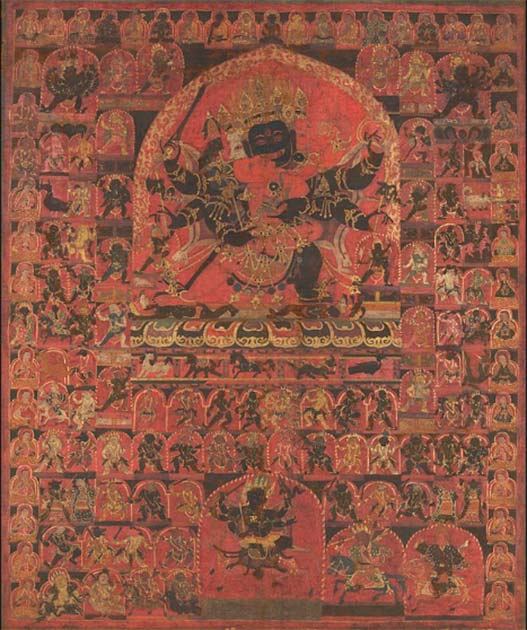
Bon Deity Tsochog Khagying – tangka, of the wrathful deities. (Metropolitan Museum of Art/ CC0)
On top of these four main deities, there is the Bon Yidams. These are the wrathful deities that are used in meditative tantric practice. This class of deities includes gods such as Magyu Sangchong Tartug, Trowo Tscochong Khagying, and Welse Ngampa. Their names translate into rather intimidating meanings such as “Fierce Piercing Deity” and “Mountain of Fire”.
On top of these, the Bon has a whole host of protector deities as well as deities that don’t fall into any other group, such as Chucham, a goddess of water. Many of these gods and goddesses blur the lines between what the west would describe as “gods” and powerful spirits.
4.There are Spirits and Demons Too
Besides numerous gods and goddesses, the Bon religion is also home to numerous spirits and demons. These beings are often associated with specific natural phenomena and geographic locations.
One of the most important types of spirit is the Lha. These are benevolent spirits that live in ceokkortain natural features like mountains, rivers, and lakes. They have the power to influence the natural world and the humans who reside within their territories. As such, it is common for the practitioners of the Bon religion to make offerings and prayers to them in exchange for their protection and blessings.
The Bon religion also has a variety of “local deities” called Tsen. Similar to the Lha, the Tsen are usually tied to certain regions of Tibet or geographical locations. They are worshiped as protectors of the land and those who live on it.
It’s not all sunshine and rainbows in Bon spiritualism, however. The Bon religion also teaches of a variety of demons and hateful spirits. Of these, one of the most powerful is said to be Agye, a being responsible for spreading illness and disease. He/It is often depicted as a fierce, demonic figure with a skull crown and a body wrapped in snakes. Where it is feared his influence has spread, rituals such as exorcisms and purification chants are used to protect the community and purify the region of Agye’s terrible influence.
Another example is the Shri, a type of female demon that targets pregnant women and children, causing things like miscarriages. It is usually depicted as a fearsome figure with a fierce expression and sharp teeth.
A less terrible form of negative spirit are the Gdon, malevolent spirits that are said to cause harm to humans. They’re usually associated with specific diseases, accidents, and natural disasters. Practitioners of Bon will often make offerings to protect against their influence.
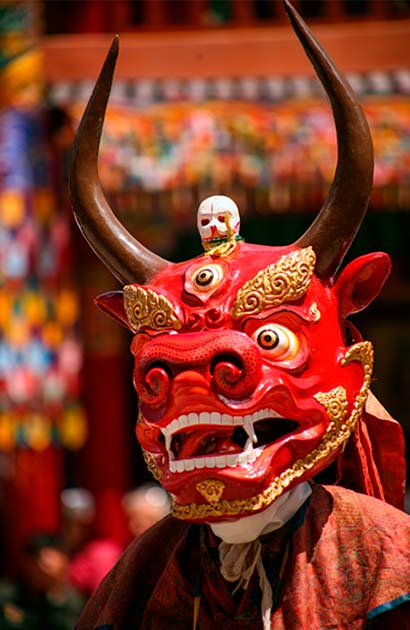
Demons of the Bon tradition are portrayed in the ritual dances. ( artqu /Adobe Stock)
5.Death in the Bon Religion is Complicated
The Bon religion has an interesting approach to life and death. Death is not viewed as the end of life but is just a part of the natural cycle of birth, death, and rebirth.
When a person first dies their soul transitions to a higher realm known as the intermediate state, bardo. This state is said to last for 49 days while the soul undergoes the purification process and is evaluated before being reborn.
During bardo, the soul goes through several different states including undergoing peaceful and wrathful visions and encountering some of the Bon religion’s many deities and spirits. The process is meant to help the soul let go of any earthly attachments and prepare for its rebirth and next life.
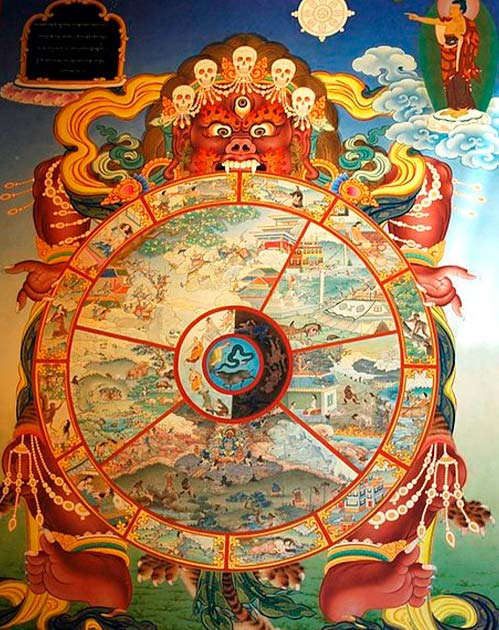
Image representing the cycle of life and death. It shows six realms of existence in which a being can reincarnate according to Bon cosmology. (Wonderlane from Seattle/ CC BY 2.0 )
While the Bon religion has no hell, its teachings do stress the importance of living a virtuous and meaningful life. How a person lives their life will shape the nature of their next rebirth.
Due to Bon’s animistic worldview humans can be reborn as pretty much anything. On the plus side, those who have lived good lives can return as people, animals, or plants. On the downside, you could come back as a lowly worm or even a rock.
The followers of the Bon religion do not have to go through bardo alone, however. There are various practices and rituals that the living can carry out to support a loved one’s soul during the bardo. Special practices such as the Chod are performed to help the soul let go of attachments and achieve a state of clarity and liberation.

Chod practitioners at Boudhanath stupa. (Christopher J. Fynn/ CC BY-SA 4.0 )
6.The Magic, Spells, and Incantations of Bon
The Bon religion places a lot of importance on the ability to communicate with the various deities, spirits, and demons. This is commonly done through the practice of making offerings to appease these beings/ bribe them for blessings.
This isn’t the only way the followers of the Bon religion can influence the spiritual reality, however. They believe in the power of magic and the use of spells and special incantations to influence the different realms.
Bon magic is commonly referred to as “phowa” or “transference” and uses ritual gestures, visualizations, and the recitation of sacred words and chants. It can be used for a whole host of purposes. It’s believed Bon healers can use magic to cure physical and spiritual ailments by reciting mantras and performing special magic rituals.
Magic can also be used for protection. Practitioners may use magic to protect themselves and their loved ones from malevolent spirits and demons. In addition to this, magic can be used for divination and prophecy to avoid trouble before it even arrives. Bon practitioners believe they can read the future through practices such as reading the patterns of yarrow sticks or the shapes of clouds.
7.Bon Rituals and Ceremonies Are Energetic
Bon rituals and ceremonies are all about creating a spiritual connection with the divine. This is done through the use of dancing, singing, and music. Music is believed to be a powerful medium for accessing the spirit realm and invoking the presence of the gods and spirits that the practitioners of Bon worship.
One of the best examples of the importance of dancing and music to the Bon religion is the cham dance, a colorful and elaborate dance that is performed in many Bon communities. It’s commonly performed by monks and other believers and usually depicts various parts of Bon cosmology, such as the gods, demons, and spirits.
The dance is accompanied by music which is played on traditional Bon instruments like drums, horns, and cymbals. It is believed the music from these instruments can induce a trancelike state in the dancers which connects them to the spirit realm.
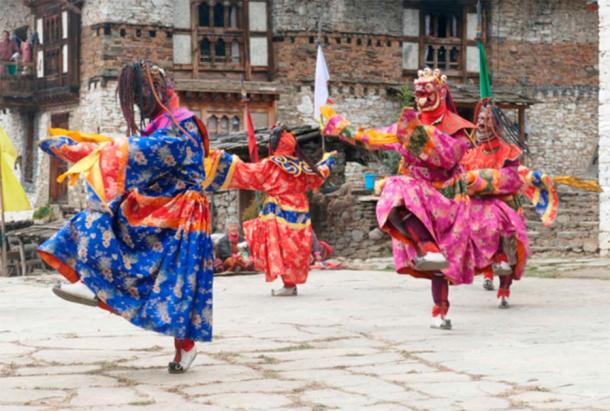
Cham dance. Wrathful deities dance to purify the ground. ( cascoly2/Adobe Stock)
These ceremonies and rituals also make use of important ritual objects which are used as tools for cultivating spiritual power and connecting to the divine. Like everything else in Bon’s animistic view, these individual objects are thought to have their own inherent spiritual powers which can be harnessed through ritual practice.
Since music is such an important part of Bon ceremonies it should not be surprising that one of their most important ritual objects is the drum. Drums are believed to represent the heartbeat of the universe and can be used to help practitioners connect to the rhythms of the world and the universe that surround it.
These Bon drums are usually made of wood and animal skin and are decorated with intricate designs. The sound they produce is said to have an energizing effect that purifies Bon worshippers.
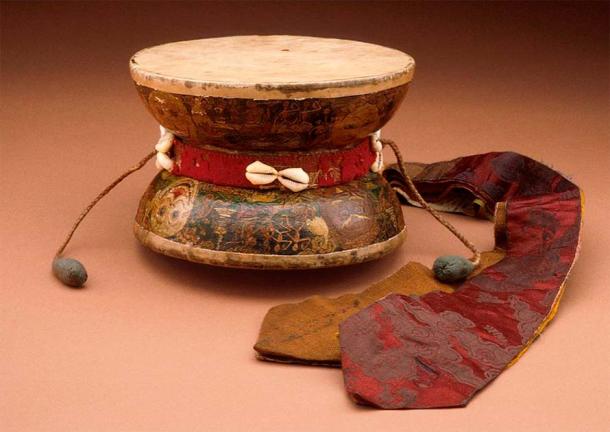
Drums are made of wood with skin and cowry shells, cotton and silk fittings . ( Public Domain )
Alongside, the drum bells also have an important ritual significance in the Bon religion. They are used to represent the feminine aspect of the divine and can clear negative energies from the environment. The bells used in Bon rituals are usually made of metal and are adorned with symbols and designs believed to have spiritual significance.
It isn’t just the musicians who get to use special ritual objects. The dancers are an equally important part of these ceremonies. They often wear colorful and elaborate masks which are believed to help the dancers embody the spiritual entities that their dances represent.
Robes and other ceremonial attire are also worn during these ceremonies and are seen as important ritual objects. Practitioners believe this special clothing has the power to protect worshippers as well as embody the spiritual qualities the dancers are depicting. Bon robes are often decorated with symbols and designs that are believed to hold special meaning.
Conclusion
From the vibrant and colorful rituals to the deep reverence for the natural world, the Bon tradition offers a unique window into the spiritual heritage of Tibet and the enduring power of the human spirit.
Perhaps what is most striking about the Bon tradition is its ability to adapt and evolve over time while remaining true to its core principles and beliefs. Despite facing numerous challenges and upheavals over the centuries, the Bon tradition has managed to survive and thrive, offering a source of inspiration and spiritual guidance to generations of Tibetans and people around the world.
Whether through the practice of meditation, the cultivation of inner peace, or the exploration of the natural world, the Bon tradition reminds us that the path to spiritual enlightenment is always open and available to those who seek it.
Top image: Tibetan monk. Source: Supermelon / Adobe Stock.
 RSS Feed
RSS Feed















 June 4th, 2023
June 4th, 2023  Awake Goy
Awake Goy  Posted in
Posted in  Tags:
Tags: 













